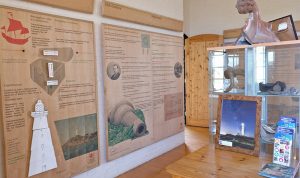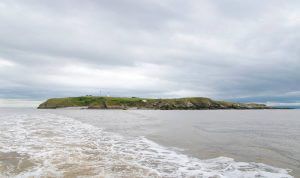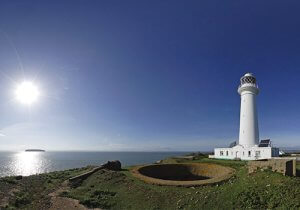History
Flat Holm Island is steeped in history with the earliest known visitor to Flat Holm being St Cadoc. He made frequent visits to the island in the late 6th century for periods of tranquil meditation, especially during Lent.
During the 18th century, the island’s location made it an ideal base for smuggling. It has been alleged that an old mine shaft on the north side of the island connects with a series of natural tunnels, and a concealed exit to the sea. Although Flat Holm is in full view of both the Welsh and English coasts, customs authorities were powerless to act as they had no boat to take them to the island. According to tradition, a small cave in the east cliff at Flat Holm was used for the storage of contraband, mainly tea and brandy.
On 13 May 1897, a 22-year-old Italian inventor named Guglielmo Marconi, assisted by a Cardiff Post Office Engineer named George Kemp, transmitted the first wireless signals over open water between Flat Holm and Lavernock Point near Penarth.
Having failed to interest the Italian government in his project, Marconi brought his telegraphy system to Britain. He erected a 34m high transmitting mast on Flat Holm as well as a 30m receiving mast at Lavernock Point. The first trials failed, but on 13 May the mast was raised to 50m and the signals were received clearly. The message sent by Morse code was “Are you ready?”; the original paper Morse slip, signed by both Marconi and Kemp, is now in the National Museum of Wales.


Flat Holm is part of the Parish of St Mary’s in Cardiff and inextricably linked to Cardiff’s history.
The axe head found on the island is believed be from the late Bronze Age, 900 to 700 BC. In the absence of any other archaeological evidence it is not known if the island was settled at that time. The Anglo-Saxons called the island “Bradanreolice”, and Steep Holm “Steopanreolice”, confirming the religious associations of the islands, as ‘reolice’ derives from an Irish word meaning churchyard or graveyard.
The earliest known visitor to Flat Holm was St Cadoc. He made frequent visits to the island in the late 6th century for periods of tranquil meditation, especially during Lent. Gildas, Barruc and Gwalches, all disciples of St Cadoc, are known to have visited Flat Holm. Gwalches and Barruc were returning from Flat Holm, where they had been sent by St Cadoc to retrieve a book forgotten on a previous visit, when the boat overturned and they were drowned. Barruc’s body was washed ashore and interred on Barry Island, whilst the body of Gwalches was carried to the Island of Echni, and buried there.
In the year 918, following their defeat by the Saxons at Watchet, Danish invaders took refuge on the islands of Steopanreolice and Bradanreolice, though for how long is uncertain. From the Anglo Saxon Chronicle:
“918 – In this year a great naval force came over here from the south of Brittany, and two earls, Ohter and Hroald with them. And they went west round the coast so that they arrived at the Severn estuary and ravaged in Wales everywhere along the coast, where it suited them… Yet they stole inland by night on two occasions – on the one occasion east of Watchet, on the other occasion at Porlock. Then on both occasions they were attacked, so that few of them got away – only those who could swim out to the ships. And then they remained out on the island of Flatholm until they became very short of food and many men had died of hunger because they could not obtain any food. Then they went from there to Dyfed, and from there to Ireland; and this was in the autumn.”
Another entry in the Anglo-Saxon Chronicle states:
“1067 – And Gytha, Harold’s mother, and many distinguished men’s wives with her, went out to Flatholme and stayed there for some time and so went from there overseas to St Omer.”
The name of Holm or Holme derives from the Scandinavian for river island and although the Danes may not have stayed on either island for long they certainly used both Flat Holm and Steep Holm as navigational aids during attacks along the Severn estuary.
 The first light was kindled on 1 December 1737. The light consisted of only a coal-fired brazier, the coal having to be carried by the keepers from the stores to the top of the tower. The light consumed large quantities of coal and 25 tonnes were landed on the island each month.
The first light was kindled on 1 December 1737. The light consisted of only a coal-fired brazier, the coal having to be carried by the keepers from the stores to the top of the tower. The light consumed large quantities of coal and 25 tonnes were landed on the island each month.
In 1819 Trinity House agreed to take over the tower from William Dickenson for the remainder of his lease and undertake the alterations.
The massive circular stone tower was adapted to make a suitable base for a lantern enclosing an oil-burning lamp. This new fixed white light was first shown on 7 September 1820. The lantern was raised a further 5 feet in 1825 and a new 14 foot diameter lantern installed in 1867, which remained until the light was converted to electricity in 1969. In 1881, the light was converted to occulting by the installation of a clockwork mechanism and now has a characteristic pattern of white and red group flashing three times every ten seconds, and a range of 21 miles. In 1997 the light was converted to run on solar power.
In 1908 a foghorn station was built. The powerful compressed air fog signal was installed in one building, whilst a cottage provided the keepers with extra accommodation. In 1929 the lighthouse became a rock station, the keepers previously having lived with their families in two cottages at the base of the lighthouse tower. These buildings then became redundant and were demolished. In more recent years the lighthouse was manned by two sets of three keepers, each working one month on the lighthouse followed by one month ashore.
In 1860 the Royal Commission recommended that Flat Holm was to form part of a “strategic coastal defence system for the Bristol Channel”, which included Brean Down, Steep Holm and Lavernock. Preparations for construction of the fortress on Flat Holm began in 1865, and it was completed in 1869. Despite the millions spent, an attack never occurred.
Due to the relatively low and exposed terrain, Moncrieff Disappearing Carriages were installed on Flat Holm. Each of these carriages carried a 7” Rifled Muzzle Loading (RML) gun, the last of the muzzle loaders, and was mounted in circular or U-shaped pits constructed of limestone and bricks. The recoil caused by the firing of the 115-pound shell forced the gun downward into the gun-pit. In the down position the gun was reloaded and then with the aid of a large counterweight, raised ready for firing once more. Not only was it difficult for an enemy ship to locate and range its guns on such a battery, but also the crews were protected within the pit, whilst servicing the gun. However, the guns were only fired in tests and their potential was never fully realised.
Nine of these guns were installed on Flat Holm in four batteries: Lighthouse, Well, Farmhouse and Castle Rock Batteries. The four batteries were all provided with magazines. Unfortunately, the carriages were comparatively easy to dismantle and have subsequently been removed, but most of the guns remain on the island, despite past efforts to salvage them for scrap, albeit in some cases without their muzzle ends.
Lighthouse Battery on the highest part of the island was integrated with defences enclosing the barracks, administrative buildings and lighthouse. The fortified area provided a fall back defence in the event of an enemy landing. The deep rock cut ditch exploited a natural geological fault and was protected by a strong parallel rampart. The battery and the Trinity House land around the lighthouse occupy the southern part of the fortified area.
To the north, the barrack block, dated VR 1869, administrative buildings and a secure store surrounded a parade ground. These provided quarters for the 50 soldiers needed to man the four batteries, but only a Master Gunner and five gunners were ever stationed on the island.
An impressive tiled water-catchment area was constructed, sloping towards a large underground water-storage tank. This tank is still in use today to collect rainwater to provide the island’s water supply.
When 22-year-old inventor, Guglielmo Marconi, brought his telegraphy system to Britain, he was introduced to William Preece, a Welshman, who was a major figure in the field and Chief Engineer of the General Post Office. Having successfully demonstrated his spark wireless telegraphy system on Salisbury Plain in March 1897, he came to Flat Holm, with his assistant George Kemp in May.
Early in May 1897, Kemp and Marconi successfully transmitted the first ever wireless signals to go over open water, between Flat Holm and Lavernock Point. The Morse slip, “Are you ready?” was sent on 13 May, signed by Signor Marconi and George Kemp.
In 1883, Flat Holm became used as an isolation hospital to protect the mainland against a cholera epidemic.
In 1892, after a serious outbreak of cholera in Hamburg, five infected vessels were discovered and moored off Flat Holm. Patients were removed and taken to Flat Holm’s hospital. The following year cholera broke out again and two more patients were taken to the hospital. The small building was proving to be insufficient and it was decided that a more substantial hospital was needed. In 1896 a new hospital was built. The main building consisted of two six-bed wards, whilst the converted building was improved to provide four extra beds. A laundry and a wooden crematorium were also constructed.
In 1935 the Ministry of Health condemned the building.
The fortification of Flat Holm started in spring 1941 and the main construction of the gun positions continued throughout 1942.
Over 350 soldiers were then stationed on Flat Holm. Two batteries under Anti-Aircraft (AA) Command were established. Both consisted of two heavy, 4.5 inch AA Mark 2 guns, a command post, and were flanked by two searchlights. Bofor and Lewis guns augmented the AA armament.
Incorporated into the design of the South Battery was the now nicknamed “Benger Goalpost”. Major D Benger, who commanded 146 Coast Battery, was worried by the proximity of his Number 2 Gun to the Lighthouse. There was considerable danger that the gun might blow the top off the tower. He had a frame of 2” steel piping erected, which forced the gun to be raised, thus avoiding the danger.
A narrow gauge railway, unusually of World War I German construction, used diesel locomotives and wagons to convey ammunition, materials and provisions across the island.
In the centre of the island there was a Radar platform on which sat the mobile radar receiving cabin, surrounded by a false horizon of wire netting. Full use was made of the old Victorian Barracks, and whilst one ward of the Cholera Hospital was turned into a NAAFI, the other was used as a cinema and concert hall, complete with projection room. Films were shown almost every fortnight, and concert parties held once a month. The farmhouse was used as the Officers’ Mess.
Flat Holm became non-operational in December 1944. In 1945/6 German prisoners of war removed most of the equipment from the military occupation.

